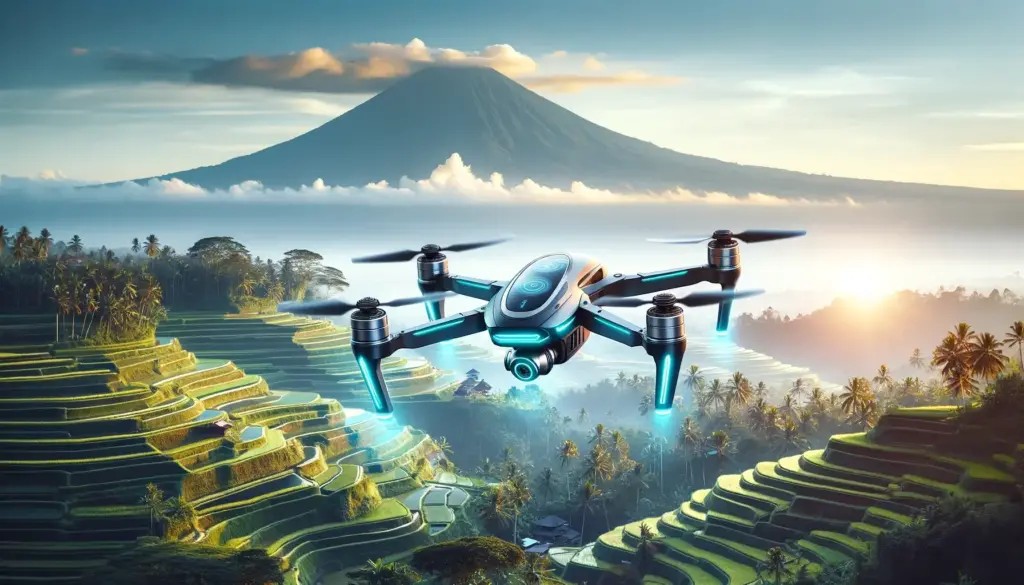Are you planning to bring your drone to Bali for your next vacation? It’s an excellent idea! Bali’s stunning landscapes and scenic beauty make it a photographer’s paradise, and capturing these moments with a drone will take your photography skills to new heights. However, before you take off, there are a few essential tips you must know to ensure a smooth and hassle-free experience.
In this article, we will provide you with valuable insights and guidelines to make the most out of your drone flying experience in Bali. From understanding the local regulations and restrictions, finding the best drone-friendly locations, to capturing breathtaking footage, we have got you covered. We will also share some useful tips to ensure the safety of your drone and others around you.
Regulations and laws for flying drones in Bali
When flying your drone in Bali, it is crucial to be aware of the local regulations and laws to avoid any legal complications. The Indonesian government has specific guidelines in place to ensure the safety and privacy of its citizens. Here are some key regulations you should keep in mind:
Firstly, drones weighing more than 250 grams must be registered with the Directorate General of Civil Aviation (DGCA). Failure to register your drone can result in hefty fines or even confiscation of your equipment. Additionally, drones are not allowed to be flown within a 500-meter radius of any airport or military facility.
Secondly, it is important to note that flying drones in certain areas such as religious sites, crowded public places, and government buildings is strictly prohibited. These restrictions are in place to respect the privacy and sanctity of these locations. Always research and check for any specific no-fly zones before planning your drone flight in Bali.
Lastly, drones should not be flown higher than 150 meters above the ground. This height limit ensures the safety of other aircraft and prevents interference with airspace regulations. It is also advisable to avoid flying near sensitive areas such as wildlife reserves or cultural heritage sites to minimize disturbance to the environment and local communities.
Understanding and adhering to these regulations will help you fly your drone responsibly and enjoy a trouble-free experience in Bali.
Best locations for drone photography in Bali
Bali is known for its diverse landscapes, ranging from lush green rice terraces to pristine beaches and majestic waterfalls. These stunning locations offer endless opportunities for drone photography. Here are some of the best spots to capture breathtaking aerial shots:
- Tegalalang Rice Terraces: Located in Ubud, these iconic rice terraces provide a mesmerizing view from above. With their neatly arranged fields and vibrant green hues, they create a visual spectacle that is perfect for drone photography. Fly your drone along the terraces to capture the intricate patterns and textures.
- Mount Batur: As one of Bali’s active volcanoes, Mount Batur offers an incredible panoramic view from its summit. Capture the sunrise or sunset from above to witness the breathtaking colors spread across the sky. Be sure to check the weather conditions and obtain permission before flying your drone near the volcano.
- Nusa Penida: This secluded island is a hidden gem just off the coast of Bali. With its rugged cliffs, crystal-clear waters, and stunning beaches, Nusa Penida provides a picturesque backdrop for aerial photography. Fly your drone along the coastline to capture the dramatic cliffs and the vibrant underwater world.
- Tanah Lot Temple: Situated on a rock formation in the sea, Tanah Lot Temple is a popular tourist attraction and a must-visit spot for drone enthusiasts. Fly your drone around the temple during low tide to capture the unique perspective of this iconic landmark against the backdrop of the ocean.
By exploring these locations and conducting thorough research, you can discover many more hidden gems in Bali that are perfect for capturing stunning aerial shots.
Tips for capturing stunning drone shots in Bali
Capturing stunning drone shots in Bali requires a combination of technical skills and artistic vision. Here are some tips to help you make the most out of your drone photography experience:
- Plan your shots: Before taking off, plan your shots and visualize the composition you want to achieve. Look for interesting subjects, leading lines, and patterns that will create visually appealing imagery. Consider the time of day and lighting conditions to enhance the mood of your shots.
- Use ND filters: Bali’s bright sunlight can often result in overexposed or washed-out footage. Using neutral density (ND) filters can help balance the exposure and reduce glare. ND filters are particularly useful when shooting waterfalls or beaches, as they allow you to capture silky smooth water and maintain detail in the highlights.
- Experiment with different angles and perspectives: Don’t be afraid to get creative with your drone shots. Try flying at different altitudes, angles, and distances to capture unique perspectives. Fly low to the ground for an intimate view or ascend higher for a bird’s-eye view of the landscape. Experimenting with different angles will add variety and depth to your shots.
- Utilize the rule of thirds: The rule of thirds is a fundamental principle of composition in photography. Imagine dividing your frame into a grid of nine equal parts, and position your main subject or points of interest along these lines or at their intersections. This technique creates a visually pleasing and balanced composition.
- Shoot in RAW: Shooting in RAW format allows for greater flexibility in post-processing. RAW files contain more data and provide better control over exposure, white balance, and color grading. This flexibility is particularly beneficial when dealing with challenging lighting conditions or when you want to achieve a specific look during post-processing.
By applying these tips and techniques, you can elevate your drone photography skills and capture stunning shots that showcase the beauty of Bali.
Essential equipment for drone photography in Bali
In addition to your drone, there are a few essential pieces of equipment that you should consider bringing with you to Bali. These items will help enhance your drone photography experience and ensure you are well-prepared for any situation. Here are some must-have accessories:
- Extra batteries: Bali’s breathtaking landscapes will tempt you to fly your drone for extended periods. Having extra batteries will ensure that you never miss out on capturing those perfect shots. Consider carrying multiple fully charged batteries to extend your flight time.
- Memory cards: Invest in high-quality, high-capacity memory cards to store your footage and images. Shooting in high resolution and RAW format can quickly fill up your memory card, so having spare cards will allow you to continue capturing without interruptions.
- Sunshade for your mobile device: Bali’s tropical climate means plenty of sunshine, which can make it challenging to see your mobile device screen while flying your drone. A sunshade or hood for your mobile device will help reduce glare and make it easier to monitor your shots.
- Drone backpack or case: Protecting your drone during transport is essential. Invest in a sturdy and well-padded backpack or case that can safely store your drone, batteries, remote controller, and other accessories. Look for a backpack or case with compartments and dividers to keep everything organized and secure.
- Lens filters: Consider investing in a set of lens filters to enhance your drone shots. Polarizing filters can reduce glare and enhance colors, while graduated neutral density (GND) filters can help balance the exposure between the sky and the ground. Experiment with different filters to achieve the desired effect in your aerial shots.
Having these essential accessories will ensure that you are well-equipped to capture stunning drone shots in Bali and make the most out of your photography adventure.
Safety precautions when flying drones in Bali
Flying a drone comes with responsibilities, and ensuring the safety of your drone and others around you should be your top priority. Here are some essential safety precautions to keep in mind when flying drones in Bali:
- Check the weather conditions: Before flying your drone, check the weather forecast for any potential rain, strong winds, or storms. Adverse weather conditions can damage your drone or even cause it to lose control. It is best to fly in calm and clear conditions to ensure a safe flight.
- Maintain line of sight: Always keep your drone within your line of sight while flying. This will help you maintain control and avoid collision with other objects or aircraft. If flying long distances, use a spotter to assist you in maintaining visual contact with your drone.
- Respect privacy: Bali is a popular tourist destination, and there may be people around you while flying your drone. Respect their privacy and avoid flying too close to individuals without their consent. Be mindful of your surroundings and ensure that your drone does not invade anyone’s personal space.
- Be cautious of wildlife: Bali is home to diverse wildlife, including birds and marine life. When flying your drone, be aware of the presence of wildlife and avoid causing disturbance or harm to them. Maintain a safe distance to minimize any potential impact on their natural behavior.
- Follow battery safety guidelines: Lithium-ion batteries used in drones can be a fire hazard if mishandled. Always follow the manufacturer’s guidelines for charging, storage, and transportation of your drone batteries. Avoid overcharging or leaving batteries unattended while charging.
By following these safety precautions, you can ensure a safe and enjoyable drone flying experience in Bali while minimizing the risk of accidents or incidents.
Drone photography etiquette in Bali
As with any form of photography, it is essential to practice good etiquette when flying your drone in Bali. Being respectful of the local culture, environment, and other individuals will help foster positive relationships and maintain a harmonious atmosphere. Here are some drone photography etiquette tips to follow:
- Observe local regulations: Familiarize yourself with the local regulations and abide by them. Respect any no-fly zones, restricted areas, or privacy restrictions that may be in place. Adhering to these regulations demonstrates your commitment to responsible drone flying.
- Be considerate of others: When flying your drone, be mindful of other individuals who may be present. Avoid flying too close to people or causing any disturbance. If someone expresses discomfort or asks you to stop flying, respect their wishes and find an alternative location.
- Minimize noise pollution: Drones can be noisy, especially in quiet and serene environments. Be conscious of the noise level produced by your drone and try to minimize any disturbance to the surroundings. Flying at higher altitudes or using propeller guards can help reduce noise levels.
- Clean up after yourself: When visiting natural locations, leave no trace behind. Ensure that you clean up any trash or debris that may be generated during your drone flight. Respect the environment and leave it as you found it, preserving its beauty for others to enjoy.
By following these etiquette tips, you can contribute to a positive drone flying culture in Bali and promote responsible and respectful drone photography.
Editing and post-processing tips for drone photos in Bali
Once you have captured stunning drone shots in Bali, the next step is to bring your images to life through editing and post-processing. Here are some tips to help you enhance your drone photos:
- Adjust exposure and white balance: Use editing software to fine-tune the exposure and white balance of your images. Balancing the exposure will help bring out details in both the highlights and shadows, while adjusting the white balance will ensure accurate color representation.
- Enhance colors and contrast: Bali’s vibrant landscapes deserve vibrant colors. Use tools such as saturation and vibrance to enhance the colors of your images. Adjust the contrast to add depth and make the subject stand out.
- Remove distractions: During post-processing, remove any distractions or unwanted elements from your images. This could be stray objects, sensor dust spots, or any other elements that may detract from the main subject.
- Crop and straighten: Use cropping and straightening tools to improve the composition of your images. Experiment with different aspect ratios and crop out any unnecessary elements to create a more visually appealing composition.
- Sharpen and add clarity: Apply sharpening and clarity adjustments to enhance the details and textures in your images. Be careful not to overdo it, as excessive sharpening can introduce artifacts and make the image appear unnatural.
Remember, editing should be used to enhance the natural beauty of your drone photos, not to completely alter the reality. Find a balance between enhancing the image and maintaining its authenticity.
Sharing your drone photos on social media and online platforms
After capturing and editing your stunning drone photos in Bali, it’s time to share them with the world! Social media and online platforms provide a great opportunity to showcase your work and connect with fellow drone enthusiasts. Here are some tips for sharing your drone photos effectively:
- Choose the right platform: Consider the platform that best suits your style and target audience. Instagram is a popular choice for visual content, while platforms like Flickr and 500px cater specifically to photographers. Research different platforms and find the one that aligns with your goals.
- Tell a story: When posting your drone photos, try to tell a story through your captions or accompanying text. Share the inspiration behind the photo, any challenges you faced while capturing it, or interesting anecdotes related to the location. Engaging storytelling will help captivate your audience.
- Use relevant hashtags: Hashtags are a powerful tool for increasing the visibility of your drone photos. Research and use relevant hashtags that are popular within the drone photography community or specific to the location you captured the image in. This will help attract more viewers and potential followers.
- Engage with the community: Social media is all about building connections. Engage with the drone photography community by liking, commenting, and following other photographers who inspire you. Participate in discussions and share your knowledge and experiences to foster meaningful relationships.
- Protect your work: While sharing your drone photos, it is essential to protect your intellectual property. Consider watermarking your images or adding copyright information to prevent unauthorized use. Additionally, be cautious of the privacy implications of sharing images that may reveal sensitive or private information.
Sharing your drone photos on social media and online platforms can provide valuable exposure and feedback for your work. Embrace the opportunity to connect with like-minded individuals and showcase the beauty of Bali through your lens.
Conclusion and final thoughts on drone photography in Bali
Bringing and flying your drone in Bali opens up a world of possibilities for capturing stunning aerial shots of this beautiful island. However, it is crucial to understand and adhere to the local regulations, respect the environment and privacy of others, and practice good drone photography etiquette.
By following the tips and guidelines provided in this article, you can make the most out of your drone flying experience in Bali.


